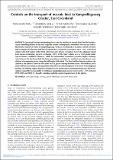Files in this item
Controls on the transport of oceanic heat to Kangerdlugssuaq Glacier, East Greenland
Item metadata
| dc.contributor.author | Cowton, Tom | |
| dc.contributor.author | Sole, Andrew | |
| dc.contributor.author | Nienow, Peter | |
| dc.contributor.author | Slater, Donald | |
| dc.contributor.author | Wilton, David | |
| dc.contributor.author | Hanna, Edward | |
| dc.date.accessioned | 2016-10-11T10:30:10Z | |
| dc.date.available | 2016-10-11T10:30:10Z | |
| dc.date.issued | 2016-12 | |
| dc.identifier | 245779351 | |
| dc.identifier | e683e7ac-a405-469b-8a37-c75543e22133 | |
| dc.identifier | 84995467492 | |
| dc.identifier | 000389173500016 | |
| dc.identifier.citation | Cowton , T , Sole , A , Nienow , P , Slater , D , Wilton , D & Hanna , E 2016 , ' Controls on the transport of oceanic heat to Kangerdlugssuaq Glacier, East Greenland ' , Journal of Glaciology , vol. 62 , no. 236 , pp. 1167-1180 . https://doi.org/10.1017/jog.2016.117 | en |
| dc.identifier.issn | 0022-1430 | |
| dc.identifier.other | RIS: urn:5120E752A878B2ACC348DEC5AD884088 | |
| dc.identifier.other | ORCID: /0000-0003-1668-7372/work/60427785 | |
| dc.identifier.other | ORCID: /0000-0001-8394-6149/work/70619152 | |
| dc.identifier.uri | https://hdl.handle.net/10023/9639 | |
| dc.description | This work was funded by NERC grant NE/K014609/1 to Peter Nienow and Andrew Sole and a NERC studentship to Donald Slater. Edward Hanna and David Wilton acknowledge support from NERC grant NE/H023402/1. | en |
| dc.description.abstract | Greenland's marine-terminating glaciers may be sensitive to oceanic heat, but the fjord processes controlling delivery of this heat to glacier termini remain poorly constrained. Here we use a three-dimensional numerical model of Kangerdlugssuaq Fjord, East Greenland, to examine controls on fjord-shelf exchange. We find that intermediary circulation can replace up to ~25% of the fjord volume with water from the shelf within 10 days, while buoyancy-driven circulation (forced by subglacial runoff from marine-terminating glaciers) exchanges ~10 % of the fjord volume over a 10 day period under typical summer conditions. However, while the intermediary circulation generates higher exchange rates between the fjord and shelf, the buoyancy-driven circulation is consistent over time hence more efficient at transporting water along the full length of the fjord. We thus find that buoyancy-driven circulation is the primary conveyor of oceanic heat to glaciers during the melt season. Intermediary circulation will however dominate during winter unless there is sufficient input of freshwater from subglacial melting. Our findings suggest that increasing shelf water temperatures and stronger buoyancy-driven circulation caused the heat available for melting at Kangerdlugssuaq Glacier to increase by ~50% between 1993-2001 and 2002-2011, broadly coincident with the onset of rapid retreat at this glacier. | |
| dc.format.extent | 14 | |
| dc.format.extent | 1029119 | |
| dc.language.iso | eng | |
| dc.relation.ispartof | Journal of Glaciology | en |
| dc.subject | Arctic glaciology | en |
| dc.subject | Calving | en |
| dc.subject | Glacier discharge | en |
| dc.subject | Ice/ocean interactions | en |
| dc.subject | GE Environmental Sciences | en |
| dc.subject | 3rd-DAS | en |
| dc.subject | BDC | en |
| dc.subject | SDG 14 - Life Below Water | en |
| dc.subject.lcc | GE | en |
| dc.title | Controls on the transport of oceanic heat to Kangerdlugssuaq Glacier, East Greenland | en |
| dc.type | Journal article | en |
| dc.contributor.institution | University of St Andrews. Bell-Edwards Geographic Data Institute | en |
| dc.contributor.institution | University of St Andrews. School of Geography & Sustainable Development | en |
| dc.contributor.institution | University of St Andrews. Geography & Sustainable Development | en |
| dc.identifier.doi | 10.1017/jog.2016.117 | |
| dc.description.status | Peer reviewed | en |
This item appears in the following Collection(s)
Items in the St Andrews Research Repository are protected by copyright, with all rights reserved, unless otherwise indicated.

